Digital Posters
Pelvic Cancer
ISMRM & SMRT Annual Meeting • 15-20 May 2021

| Concurrent 5 | 15:00 - 16:00 |
3888. |
In vitro validation of a real-time 3D MRI Urodynamics Protocol
Colin Kim1, Cody Johnson1, James Rice2, and Alejandro Roldán-Alzate1
1Medical Physics and Radiology, University of Wisconsin-Madison, Madison, WI, United States, 2Mechanical Engineering, University of Wisconsin-Madison, Madison, WI, United States
Lower urinary tract symptoms (LUTS) and changes in bladder function occur frequently as individuals age, requiring a non-invasive method of imaging the bladder. This study utilized 3D MRI acquisition on both an in vitro bladder model and an in vivo human subject to analyze deformation patterns during the bladder voiding process and validated results with high-speed optical imaging. Both quantitative and qualitative analyses were conducted. This study serves to discover novel methods of in vivo MRI bladder imaging during the voiding process.
|
|||
3889.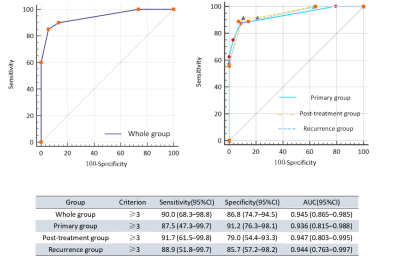 |
Preliminary Exploration of Expanding the Target Population of VI-RADS - Could Patients After Treatment Benefit from It?
Bohong Cao1, Qing Li1, Peirong Xu2, Pu-Yeh Wu3, Shuai Jiang2, and Jianjun Zhou1
1Radiology, Zhongshan Hospital Fudan University, Shanghai, China, 2Urology, Zhongshan Hospital Fudan University, Shanghai, China, 3MR Research, GE Healthcare, MR Research, Beijing, China
In this study, we expanded the target population by including patients after treatment and with recurrent bladder cancer to further evaluate the diagnostic performance of VI-RADS. The diagnostic performances of VI-RADS were good in all subgroups including the primary, post-treatment and recurrence groups (AUC > 0.90). No significant differences were observed in diagnostic efficacy of VI-RADS between the primary group and the post-treatment group, and between the primary group and the recurrence group. Overall, this study demonstrated that VI-RADS can be considered an effective preoperative imaging staging tool for a wider range of bladder cancer patients.
|
|||
3890.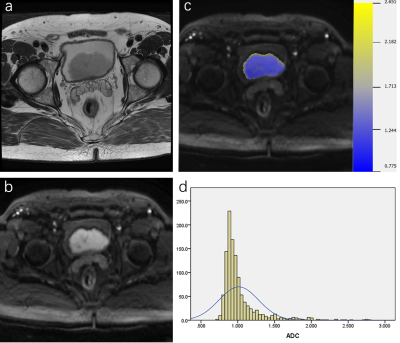 |
Combining Volumetric ADC Histogram Analysis with Vesical Imaging Reporting and Data System to Predict the Muscle Invasion of Bladder Cancer
Shichao Li1, Ping Liang1, Yanchun Wang1, Yaqi Shen1, Xuemei Hu1, Daoyu Hu1, Xiaoyan Meng1, and Zhen Li1
1Department of Radiology, Tongji Hospital, Tongji Medical College, Huazhong University of Science and Technology, Wuhan, China
This study explored the clinical value of volumetric apparent diffusion coefficient (ADC) histogram analysis and Vesical Imaging Reporting and Data System (VI-RADS) in differentiating muscle-invasive bladder cancer (MIBC) from non-muscle-invasive bladder cancer (NMIBC), and demonstrated that both are helpful and the volumetric ADC histogram can provide additional value to VI-RADS.
|
|||
3891.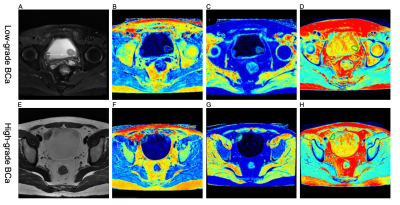 |
Investigation of synthetic MRI applied in the evaluation of tumor grade of bladder cancer
Qian Cai1, Huan jun Wang1, Yi ping Huang1, Long Qian2, Yan Guo1, Zhi hua Wen1, Long yuan Ouyang1, and Mei qin Li1
1Department of Radiology, The First Affiliated Hospital of Sun Yat-sen University, Guangzhou, China, 2MR Research, GE Healthcare, Beijing, China
The prospective study aims to investigate the value of Synthetic MRI in evaluating the grading of bladder cancer (BCa). A total of 31 patients with pathologically confirmed BCa were enrolled. Regions of interest were manually drawn by two radiologists. Our results indicated that there were significant differences in the mean T2 and PD values between high- and low-grade BCa. The area under the ROC curve of the mean T2 and PD values were 0.761 and 0.880, respectively. Synthetic MRI is helpful for discriminating low- and high-grade BCa.
|
|||
3892.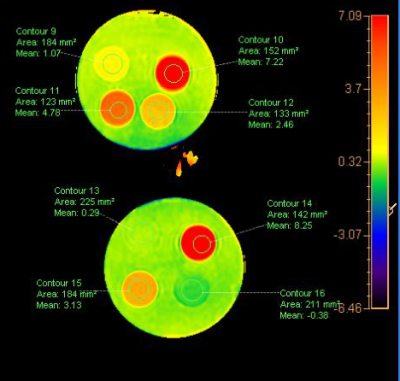 |
Inhibition of Urine Amide Proton Transfer Signal with Optimal Scan Parameters in Bladder Cancer
Bo Dai1, Meiyun Wang 1, Fengshan Yan1, Zhiwei Shen2, Yan Bai1, and Nan Meng1
1Henan Provincial People's Hospital, Zhengzhou, China, 2Philips healthcare, Beijing, China
In the preliminary experiment, we found that there were hyperintense amide proton transfer weighted (APTw) signal in urine, which may interfere with the contrast of APTw signal in bladder lesion. In this study, we aim to explore the feasibility and features of urine APTw imaging in vitro and in vivo, and inhibite the urine APTw signal for better display of bladder lesions using optimal parameters.
|
|||
3893.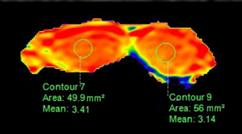 |
The change of amide proton transfer (APT) signal intensity (SI) with age in testes of adults: A preliminary study
Wenhao Fu1, Yang Peng1, Guanglei Tang1, Weibo Chen2, Kan Deng3, Zhongping Zhang3, Yingjie Mei3, and Jian Guan1
1Department of Radiology, the First Affiliated Hospital of Sun Yat-Sen University, Guangzhou, China, 2Philips Healthcare, Shanghai, China, 3Philips Healthcare, Guangzhou, China
Functional MRI, such as DWI and MTI, have been used to evaluate male infertility. Amide proton transfer (APT) is a novel MRI technique in the level of molecular imaging, which employs the chemical exchange of endogenous amide proton. This study investigated the relationship between amide proton transfer (APT) signal intensity (SI) changes with age in adults. According to the initial results of this research, we found that APT SI of testes was positively correlated age, which suggested that APT could be a potential biomarker for spermatogenic function.
|
|||
3894.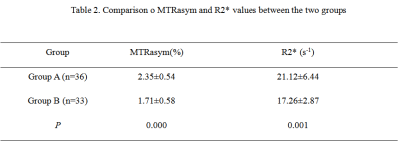 |
Improved the performance of differential diagnosis between Prostate Cancer and Benign Prostate Hyperplasia using APT and mDIXON-Quant
Xue Ren1, Ailian Liu1, Lihua Chen1, Shuang Li1, Yue Wang1, Jiazheng Wang2, Qingwei Song1, Sun Peng2, Renwang Pu3, and Yuanfei Li1
1The First Affiliated Hospital of Dalian Medical University, Dalian, China, 2Philips Healthcare, Beijing, China, 3First Affiliated Hospital of Dalian Medical University, Dalian, China
Accurate identifying prostate cancer (PC) from benign prostatic hyperplasia (BPH) is of great significance for timely and proper treatment. Amide proton transfer (APT) is a novel MRI method sensitive to several kinds of cancers. mDIXON-Quant is a powerful quantitive technique for simultaneous fat quantification and R2* mapping, which can reflect the tissue contents and properties. This study aims to assess the diagnostic performance of APT and mDIXON-Quant on differentiating prostate cancers and benign prostate hyperplasia. Results indicate that the combination of APT and mDIXON-Quant can enhance the differential diagnosis of PC and BPH.
|
|||
3895.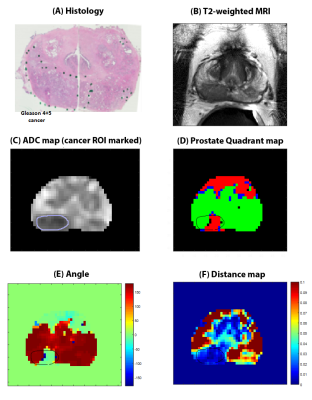 |
Four Quadrant mapping of Hybrid Multidimensional MRI data for the diagnosis of prostate cancer
Aritrick Chatterjee1,2, Xiaobing Fan1, Aytekin Oto 1,2, and Gregory Karczmar1,2
1Department of Radiology, University of Chicago, Chicago, IL, United States, 2Sanford J. Grossman Center of Excellence in Prostate Imaging and Image Guided Therapy, Chicago, IL, United States
This study introduces a new quantitative mapping technique referred to as Four Quadrant mapping of Hybrid Multi-dimensional MRI data and evaluates its use for diagnosis of prostate cancer. Each image voxel can be represented as a vector in a 2D plot with components ‘∆T2/∆b’ and ‘∆ADC/∆TE’. Cancers contain a significantly higher percentage of voxels in quadrant 4 (PQ4), and a lower percentage of voxels in quadrant 2 (PQ2), smaller amplitude and angle compared to benign tissue. The quadrant analysis metrics resulted in AUC of 0.893 for differentiation of cancer from benign tissue, and showed moderate correlation with Gleason score (|ρ|=0.38-0.61).
|
|||
3896.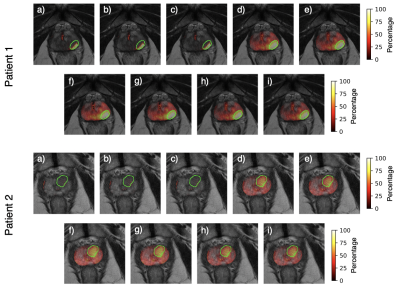 |
Assessing the combined effect of bias field correction and intensity normalization of T2w images on prostate tumor probability maps
Stephanie Alley1, Uulke Van der Heide2, Cynthia Ménard3, and Samuel Kadoury1,3
1Biomedical Engineering, Polytechnique Montréal, Montréal, QC, Canada, 2Radiation Oncology, The Netherlands Cancer Institute, Amsterdam, Netherlands, 3Centre Hospitalier de l’Université de Montréal, Montréal, QC, Canada
Multi-parametric magnetic resonance imaging has come to play an important role in the diagnosis and treatment of prostate cancer. Despite numerous advances in the acquisition, processing, and analysis of these images, a great deal of variability still exists in the reliability of imaging-based information. In an effort to initialize a framework for standardizing the processing of prostate imaging data, we present a systematic evaluation of the effect that bias field correction and intensity normalization of T2w images have on downstream analyses. We show that this assessment allows us to achieve improved accuracy for tumor localization within the prostate.
|
|||
3897.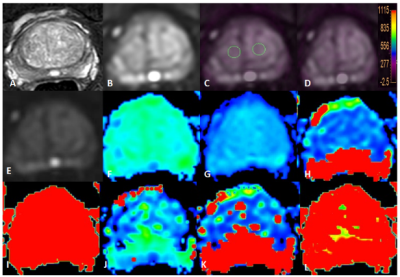 |
Correlation between T2 mapping and Intravoxel Incoherent Motion in Prostate cancer and Benign prostatic hyperplasia
Nila Mu1, Ailian Liu1, Lihua Chen1, Pengyun Zhang1, Yunsong Liu1, Changjun Ma1, Jiazheng Wang2, Liangjie Lin2, Qingwei Song1, and Renwang Pu1
1The First Affiliated Hospital of Dalian Medical University, Dalian, China, Dalian, China, 2Philips Healthcare, Beijing, China, Beijing, China
It is difficult to identify prostate tumors and prostate hyperplasia in clinical practice with conventional MR imaging methods. T2mapping is a non-invasive technique, which can analyze the T2 value of the organization quantitatively. In this study, we aimed to evaluate the correlation between T2 mapping and Intravoxel incoherent motion. The results show that T2 values were significantly associated with all parameters of IVIM except fast ADC mono, and have no concern with prostate cancer or benign prostatic hyperplasia.
|
|||
3898.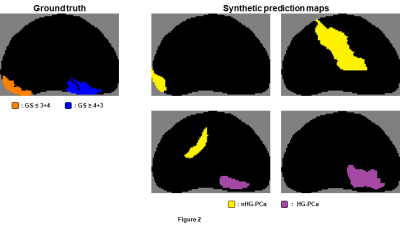 |
Two-stage classifier for detection of high-grade prostate cancer using quantitative MRI and radiomic features
Ethan Leng1, Joseph Koopmeiners2, Lin Zhang2, and Gregory John Metzger1
1Center for Magnetic Resonance Research, Minneapolis, MN, United States, 2School of Public Health, Division of Biostatistics, University of Minnesota, Minneapolis, MN, United States
It is important to not only identify prostate cancer (PCa) when it is present, but also to determine the aggressiveness of PCa. In this work, we developed a novel two-stage classification model for simultaneous detection of PCa on prostate MRI and localization of aggressive, high-grade PCa, using both quantitative MRI and radiomic features. The first-stage classifier was trained to detect cancer on a voxel-wise basis, and achieved an AUC of 0.818. The second-stage classifier was trained to predict the aggressiveness of candidate regions automatically derived from the voxel-wise predictions of the first stage, and achieved an AUC of 0.779.
|
|||
3899. |
Improved differential diagnosis between Prostate Cancer and Benign Prostate Hyperplasia using APT and IVIM
Lihua Chen1, Ailian Liu1, Pengyun Zhang1, Nila Mu1, Yunsong Liu1, Changjun Ma1, Jiazheng Wang2, Qingwei Song1, and Renwang Pu1
1The First Affiliated Hospital of Dalian Medical University, Dalian, China, 2Philips Healthcare, Beijing, China
It is difficult to differentiate prostate tumors and prostate hyperplasia using conventional MR imaging methods. Amide proton transfer-weighted imaging is a novel MRI imaging tool for detection of amide protons in mobile cellular proteins and peptides. We aimed to evaluate the differential diagnosis of prostate cancers and benign prostatic hyperplasia using APT and IVIM. Results showed that prostate cancers were associated with higher APT values than benign prostate hyperplasia, while diffusion and perfusion parameters of IVIM were lower in prostate cancers. The diagnostic efficiency between prostate cancer and prostatic hyperplasia was higher with combinational use of APT and IVIM parameters.
|
|||
3900.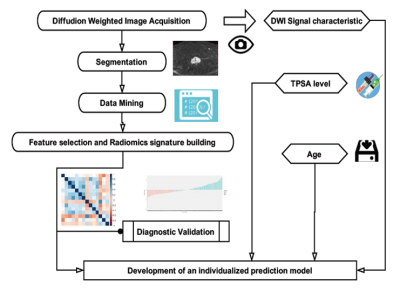 |
Development and validation of radiomics model for diagnosing PCar and BPH based on Diffusion weighted imaging and clinical information
Lihua Chen1, Ailian Liu1, Yan Guo2, and Xin Li2
1The First Affiliated Hospital of DaLian Medical University, Dalian, China, 2GE Healthcare, China, Beijing, China
DWI might be used as a biomarker for tumor aggressiveness, and various reports have been made on using DWI in distinguishing PCa from BPH. The primary parameter of DWI, ADC must be obtained with a high b value DWI, to limit the perfusion effect. The term radiomics has attracted increased attention in recent years, which was presented by Lambin in 2012. The aim of this study was to establish and evaluate the efficiency of radiomics model in distinguishing PCa from BPH based on DWI sequence and clinical information, and to compare the efficiency of ROI sketched by two different methods.
|
|||
3901.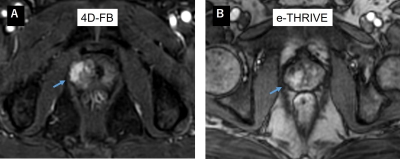 |
The Usefulness of Variable-density Stack-of-Stars Acquisition in Dynamic Gadolinium-Enhanced MRI of Prostate Cancer: A Preliminary Study
Shintaro Horii1, Yoshiko Ueno2, Yuichiro Somia1, Ryuji Shimada1, Keitaro Sofue2, Yasuyo Urase2, Wakiko Tani1, Yu Ueda3, Akiko Kusaka1, and Takamichi Murakami2
1Center for Radiology and Radiation Oncology, Kobe University Hospital, kobe, Japan, 2Department of Radiology, Kobe University Graduate School of Medicine, Kobe University Hospital, kobe, Japan, 3Philips Japan MR Clinical Science, tokyo, Japan
This study aimed to compare the image quality and the quantitative DCE-MRI parameters using the k-space weighted image contrast reconstruction with variable-density golden angle stack-of-stars acquisition (4D-FB) to those of the conventional 3D-T1W turbo field echo sequence (e-THRIVE) in prostate cancer (PCa). Image quality assessment and the receiver operating characteristic curve (AUC) analysis of quantitative DCE-MRI parameters in discrimination PCa from normal tissue were performed. 4D-FB showed significantly higher SNR compared to e-THRIVE. No significant differences were observed in AUCs for each quantitative DCE-MRI parameter. 4D-FB may improve image quality of DCE-MRI with keeping effective pharmacokinetic information in PCa assessment.
|
|||
3902.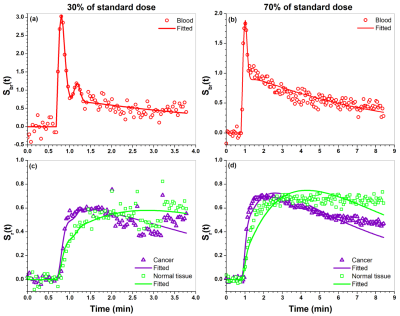 |
Effectiveness of split dose of gadoterate meglumine injection using 30% and 70% of standard dose to detect prostate cancer using ultrafast DCE-MRI
Xiaobing Fan1, Aritrick Chatterjee1, Jay M Pittman1, Ambereen Yousuf1, Tatjana Antic2, Gregory S Karczmar1, and Aytekin Oto1
1Radiology, The University of Chicago, Chicago, IL, United States, 2Pathology, The University of Chicago, Chicago, IL, United States
We evaluated dynamic contrast enhanced MRI with a split injection protocol for diagnosis of prostate-cancer. We injected 30% of the standard dose, followed after two mins by 70% of the standard dose of gadoterat-meglumine. A signal intensity form of the standard Tofts model was used to extract physiological parameters. On average cancer had larger Ktrans and smaller ve than normal tissue obtained from both doses. Receiver operating characteristic analysis showed that area under curve was 0.776 for a combination of all parameters from the 30% and 70% doses. The split injection protocol combined with quantitative analysis may increase diagnostic accuracy.
|
|||
3903.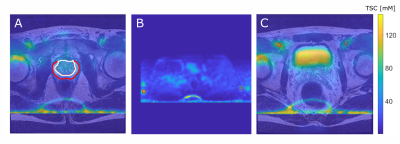 |
23Na MRI in Patients with suspected Prostate Cancer: External and Internal References for Quantification of Tissue Sodium Concentration
Anne Adlung1, Fabian Tollens2, Nadia Karina Paschke1, Jennifer Hümsch1, Niklas Westhoff3, Daniel Hausmann2,4, Lothar Rudi Schad1, Dominik Nörenberg2, and Frank Gerrit Zöllner1,5
1Computer Assisted Clinical Medicine, Medical Faculty Mannheim, Heidelberg University, Mannheim, Germany, 2Department of Radiology and Nuclear Medicine, Medical Faculty Mannheim, Heidelberg University, Mannheim, Germany, 3Department of Urology and Urosurgery, Medical Faculty Mannheim, Heidelberg University, Mannheim, Germany, 4Department of Radiology, Kantonspital Baden, Baden, Switzerland, 5Mannheim Institute for Intelligent System in Medicine, Medical Faculty Mannheim, Heidelberg University, Mannheim, Germany Prostate cancer is the most common tumor in men. 23Na-MRI provides complementary information to multiparametric-MRI. Tissue sodium concentration (TSC) quantification depends on sodium references-usually external phantoms. This study investigates TSC-quantification based on internal references (iliac-artery). 23Na-MRI of 19 male patients with suspected PCa was included. TSC in the prostate was quantified based on external reference vials and based on the iliac artery. Three patients showed a PI-RADs-5 lesion and had an elevated TSC which is in alignment with prvious studies. No significant differences between both methods were found in the whole prostate. Internal references for TSC quantification could simplify 23Na-MRI. |
|||
3904.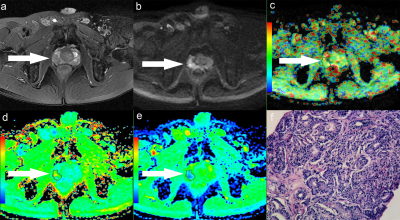 |
A comparison study of the value of Diffusion Kurtosis Imaging and Amide Proton Transfer imaging in the evaluation of prostate cancer
Huijia Yin1, Dongdong Wang1, Ruifang Yan1, Xuekun Li1, Kaiyu Wang2, and Dongming Han1
1MR, the First Affiliated Hospital of Xinxiang Medical University, Xinxiang, China, 2MR Research China,GE Healthcare, Xinxiang, China
This study explored the diagnostic value of APT and DKI in prostate cancer(PCa) and benign prostatic hyperplasia(BPH), and compared the diagnostic advantages of the two techniques and their relationship with the risk of prostate cancer. Our study have shown that APT and DKI both can differentiate PCa and BPH, but DKI has higher diagnostic value, and have strong correlation with Gleason score.They all have the potential to be used in routine clinical practice as new indicators to evaluate the risk of PCa, and to help early diagnosis and personalized diagnosis and treatment of PCa.
|
|||
3905.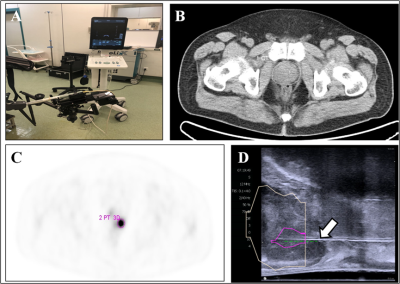 |
A pilot study of 18F-PSMA PET/CT or PET/MRI and ultrasound fusion targeted prostate biopsy for intra-prostatic PET-positive lesions
Yachao Liu1, Hongkai Yu2, Jiajin Liu1, Xiaojun Zhang1, Mu Lin3, Holger Schmidt4, Jiangping Gao2, and Baixuan Xu1
1Department of Nuclear Medicine, Chinese PLA General Hospital, Beijing, China, 2Department of Urology Surgery, Chinese PLA General Hospital, Beijing, China, 3MR collaborations, Diagnostic Imaging, Siemens Healthcare, Shanghai, China, 4MR Education, Customer Services, Siemens Healthcare, Erlangen, Germany
The purpose of this study is to evaluate the feasibility and diagnostic performance of 18F-PSMA PET/CT-ultrasound (PET/CT-US) or PET/MRI-ultrasound (PET/MRI-US) fusion targeted biopsy for intra-prostatic PET-positive lesions. 55 candidates were prospectively enrolled for PET/CT-US or PET/MRI-US fusion targeted biopsies at solitary PET-positive lesions. A total of 178 core biopsies were performed on 55 patients. 146 biopsy cores (82.0%, 146/178) from 51 (92.7%, 51/55) patients were positive for prostate cancer; 47 (85.5%, 47/55) were clinically significant prostate cancer. 18F-PSMA PET/CT-US or PET/MRI-US fusion-targeted prostate biopsy are feasible for prostate cancer diagnosis and has high detection rate of clinically significant prostate cancer.
|
|||
3906.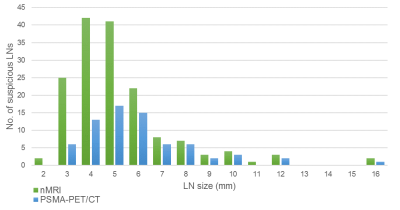 |
Head-to-head comparison of PSMA-PET/CT and ferumoxtran-10-enhanced MRI for the diagnosis of lymph node metastases in prostate cancer patients
Melline Gabrielle Maria Schilham1, Patrik Zamecnik1, Bas Israel1, Bastiaan Privé1, Mark Rijpkema1, Jelle Barentsz1, James Nagarajah1, Martin Gotthardt1, and Tom Scheenen1
1Medical Imaging, Radboudumc, Nijmegen, Netherlands
In this head-to-head comparison study, 45 prostate cancer patients underwent both USPIO-enhanced MRI (nano-MRI) and prostate-specific membrane antigen PET/CT for the purpose of lymph node staging. The results of both scans were compared on number, size and location of suspicious lymph nodes. Both modalities identified suspicious LNs which were missed by the other. Both modalities identified suspicious LNs in all anatomical regions of the pelvis, however nano-MRI appeared to be superior in detecting smaller suspicious LNs.
|
The International Society for Magnetic Resonance in Medicine is accredited by the Accreditation Council for Continuing Medical Education to provide continuing medical education for physicians.